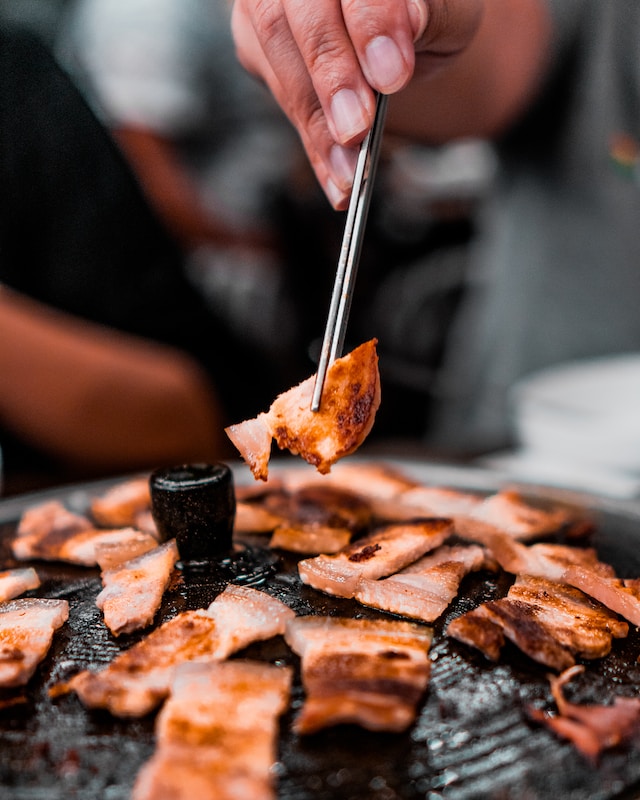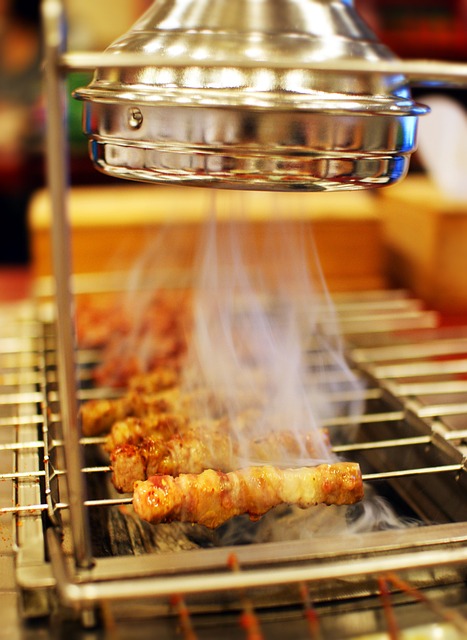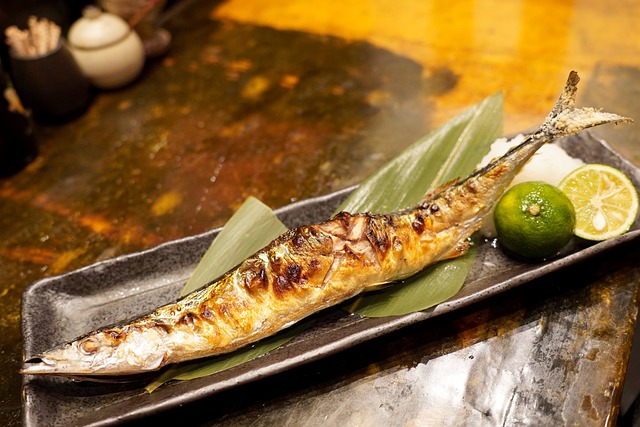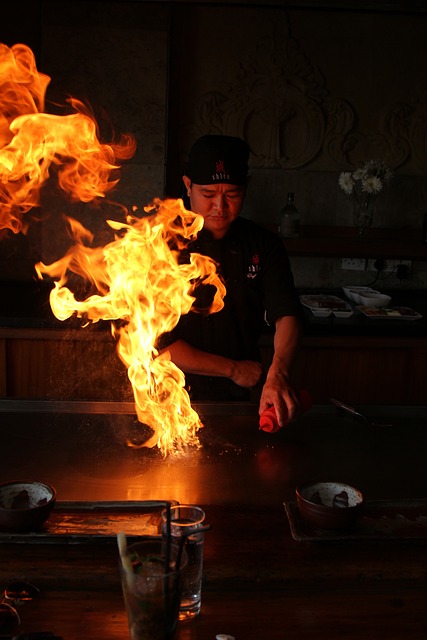
Summer is in full swing, and what better way to celebrate than firing up the grill? The sizzle of juicy steaks, the aroma of smoky barbecue sauce, and the laughter of friends and family gathered around the flames – it’s a quintessential summer experience that can’t be beaten.
When it comes to grilling, there are endless possibilities. You can throw on classic burgers and hot dogs for a crowd-pleasing meal, or get creative with marinated chicken skewers, grilled shrimp tacos, or smoky pork ribs. And let’s not forget about the sides – charred corn on the cob, grilled vegetables, and garlic bread straight off the grill are all must-haves for any summer feast.
That’s what you think when you think of “grilling” in American culture, and it’s absolutely delicious. Now take those elements, make them smaller, emphasize fresh vegetables and thin slices of high-quality Wagyu, and now you’re talking about Japanese grilling – Yakimono or Yakiniku!
Let me tell you about “Yakimono”.
Yakimono is a traditional Japanese grilling method that has been used for centuries. This technique in Japanese cooking emphasizes the quality of the ingredients, and it involves grilling thin slices of meat and vegetables over a high heat. The key to Yakimono is to cook the items quickly and to keep them juicy and flavorful. The result is a mouth-watering meal that is both healthy and extremely satisfying.
While Yakimono is often associated with beef, there are many other meats and vegetables that are traditionally grilled using this method. Thinly sliced pork belly, chicken, and seafood are all popular options. Vegetables such as asparagus, zucchini, and mushrooms are also perfect for grilling with Yakimono.
One of the joys of Yakimono is that it is typically enjoyed outdoors – on patios, balconies or in gardens. With the aromas of sizzling meat and vegetables filling the air, it’s easy to imagine you’re in a bustling Japanese market. And just like in Japan, Yakimono is often enjoyed with a cold beer or a glass of sake, especially in izakayas and pubs.
Places like Omoide Yokocho in Shinjuku, for instance, where yakitori or grilled chicken is a staple, are popular end-of-the-day destinations for many locals.
Yakitori
Yakitori, the famous Japanese grilled chicken, is a food lover’s delight that deserves a section of its own. With its roots deep in the streets of Tokyo, Yakitori has gained international fame and captured the hearts (and taste buds) of countless food enthusiasts.
The Origins of Yakitori
Yakitori, which literally means “grilled bird,” originated in Japan during the Edo period. Back then, street vendors would skewer small pieces of chicken and grill them over charcoal fires. The enticing aroma and irresistible taste quickly made Yakitori a popular snack among locals, and it has remained an integral part of Japanese cuisine ever since.
Yakitori is not just about throwing chicken on the grill; it’s about precision and mastery of the grilling technique. Experienced Yakitori chefs are known for their meticulous attention to detail, selecting the perfect cuts of chicken and carefully preparing the skewers.

Selecting the Chicken
When it comes to Yakitori, the type of chicken used plays a crucial role in the flavor profile. The most sought-after chicken for Yakitori is the Nagoya Cochin breed, known for its tender meat and rich umami flavor. Other popular choices include Tsukune (chicken meatballs), Momo (thigh), Negima (chicken and leek), and Tebasaki (chicken wings).
Perfecting the Grill
Charcoal grilling is the preferred method of cooking Yakitori, as it provides that distinct smoky essence that elevates the dish to new heights. The grill’s heat must be carefully controlled to ensure the chicken cooks evenly, retaining its succulence and juiciness while developing a beautiful charred exterior.
The Variety of Flavors
Part of Yakitori’s allure lies in the variety of flavors available. As each skewer cooks on the grill, it is basted with a special tare sauce, which adds a delightful sweet and savory glaze. Traditional tare sauces include soy sauce-based variants such as Teriyaki, Hatsu (chicken heart) sauce, and Yakitori no Tare, a blend of rich soy sauce, mirin, sake, and sugar.
Accompaniments and Pairings
Yakitori is often enjoyed in Izakayas, Japanese gastropubs, where it is served alongside a range of delectable side dishes. Popular accompaniments include cabbage salad, pickled vegetables, miso soup, and rice. To complement the flavors of Yakitori, many choose to pair it with a refreshing beer, sake, or even a chilled glass of high-quality matcha.
Robatayaki
When it comes to grilling, there is one Japanese culinary technique that stands out – Robatayaki. With roots in the northern city of Hokkaido, Robatayaki is a traditional method of cooking that brings together the flavors of the sea and the land over a charcoal grill. Let’s dive into the world of Robatayaki and explore the art of charcoal grill cooking.
The Origins of Robatayaki

Robatayaki, which translates to “fireside cooking,” originated in Hokkaido, where fishermen would gather around a charcoal pit to grill the day’s catch. The fishermen would spear their choice cuts of fish or seafood onto long skewers and cook them over an open flame. This communal cooking style soon spread throughout Japan, becoming a popular way to enjoy fresh, grilled delicacies.
The Robatayaki Experience
At the heart of Robatayaki is the charcoal grill, known as a robata. It consists of a long, rectangular clay or metal pit usually built into the counter or floor of a traditional Robatayaki restaurant. The grill is divided into different heat zones, allowing for precise control of the cooking process.
One of the unique aspects of Robatayaki is the interaction between the chef and the diners. Picture yourself sitting at the counter of a Robatayaki restaurant, where the grill stretches before you. From behind the counter, the chef will present a variety of skewers, each offering a tantalizing ingredient.
The chef and diners engage in a lively exchange as they choose their skewers. The chef will then grill the chosen items, displaying both skill and showmanship. The aroma of the grilling ingredients fills the air, heightening anticipation and whetting the appetite.
A Feast of Flavors
When it comes to Robatayaki, the possibilities are endless. The grill accommodates an array of ingredients, ranging from the freshest seafood, such as scallops, prawns, and squid, to succulent cuts of meat like Wagyu beef and tender chicken. Vegetables like mushrooms, asparagus, and bell peppers are also grilled to perfection, enhancing the overall flavor profile.
Each skewer is lightly seasoned with salt or a simple marinade, allowing the natural flavors of the ingredients to shine. As the items slowly cook over the smoky, charcoal heat, they develop a delicious char and retain their juiciness.
Serving and Pairing
Robatayaki is usually served hot off the grill, allowing diners to experience the ingredients at their peak. Skewers are often enjoyed on their own, relished for their simplicity and quality. However, they can also be accompanied by refreshing side dishes like vinegared salads, miso soup, and rice.
To complement the grilled flavors, many choose to pair Robatayaki with a variety of beverages. Sake is a popular choice, as it harmonizes with the earthy taste of the charcoal-grilled ingredients. For those seeking a non-alcoholic option, green tea or a fizzy Japanese soda can provide a refreshing contrast.
Robatayaki represents more than just a cooking technique – it embodies a shared experience, a celebration of food and camaraderie. As you explore the world of grilling, consider incorporating the art of Robatayaki into your culinary repertoire. Allow the charcoal grill to elevate your ingredients, and immerse yourself in the tradition and flavors of this unique Japanese cooking method. With Robatayaki, your grilling experiences will never be the same again.
Teppanyaki

When it comes to grilling, one cannot overlook the theatrical and mouth-watering experience of Teppanyaki. Derived from the Japanese words “teppan” (iron plate) and “yaki” (grilled), Teppanyaki is a style of cooking that involves a skilled chef preparing food on a hot iron plate right in front of you. Let’s delve into the captivating world of Teppanyaki and discover the art of iron plate grilling.
Teppanyaki traces its roots back to post-war Japan in the 1940s. Inspired by Western-style cooking techniques, chefs began to experiment with grilling meat, seafood, and vegetables on large iron plates. What started as a small dining trend in Tokyo quickly gained popularity, captivating audiences with its interactive cooking style and flavorful dishes.
The Teppanyaki Grill Setup
At the heart of a Teppanyaki restaurant is the teppan grill. This large, flat iron plate is heated to a scorching high temperature, creating the perfect surface for searing and cooking ingredients to perfection. The grill is typically set in the middle of a communal table, surrounded by seating where guests can fully enjoy the culinary performance.
As you take your seat at the Teppanyaki table, you will find front-row access to the culinary artistry that is about to unfold. A skilled chef will be your guide through the gastronomic journey, showcasing their precision knife skills and impressive culinary techniques. The entertainment factor is one of the highlights of Teppanyaki, as the chef skillfully flips, chops, and grills ingredients with flair.
A Feast for the Senses
Teppanyaki showcases an impressive array of ingredients, each carefully selected to maximize flavor and texture. From succulent steak and plump shrimp to tender chicken and fresh seafood like scallops and lobster, the options are abundant. Vegetarians need not fret, as Teppanyaki also offers an array of grilled vegetables such as zucchini, onions, and mushrooms, providing a delightful symphony of flavors.
Seasonings and Sauces
To enhance the flavors of the grilled ingredients, chefs often sprinkle them with a touch of salt or a special seasoning mix. Additionally, various sauces are employed to provide an extra burst of flavor. Classic sauces like garlic butter, soy-based sauce, and tangy teriyaki are commonly used, elevating the taste profile of the dishes and adding a satisfying depth of flavor.
Accompaniments and Pairings
A Teppanyaki feast is usually served with a range of complementary dishes. Steamed rice, stir-fried noodles, and crispy vegetables often accompany the grilled main course, offering a well-rounded meal. To pair with the robust flavors of Teppanyaki, guests can choose from a selection of sake, wine, or refreshing aromatics like green tea or Japanese plum wine.
Sumibi Yakiniku
When it comes to grilling, there is a method that stands apart – Sumibi Yakiniku. Translated as “charcoal-grilled meat,” Sumibi Yakiniku is a Japanese culinary delight that combines the art of grilling with the highest quality cuts of meat.
Sumibi Yakiniku is all about embracing the natural flavors of the meat and infusing it with the aromatic essence of charcoal. With Sumibi Yakiniku, the focus is on the meat itself, allowing it to shine. The grilling process intensifies the flavors, creating a smoky, caramelized crust that seals in the juiciness and tenderness within.

The Charcoal Experience
At the heart of Sumibi Yakiniku is the use of high-quality charcoal. Binchotan, a premium Japanese charcoal known for its slow-burning properties, is often used to achieve the perfect balance of heat and flavor. The smoky aroma released by the charcoal adds another layer of deliciousness to the grilled meat.
Sumibi Yakiniku offers a wide variety of meat cuts to choose from, each with its own unique texture and flavor profile. The most popular choices include succulent Wagyu beef, melt-in-your-mouth Kobe beef, juicy pork belly, and flavorful chicken. Each cut of meat is carefully selected to ensure the highest quality and enjoyment.
Marinating and Seasoning
Before the grilling process begins, the meat is often marinated or lightly seasoned to enhance its flavor. Traditional marinades may include a mixture of soy sauce, mirin, sake, garlic, ginger, and other spices. The marinade helps to tenderize the meat and infuse it with a rich umami taste.
Sumibi Yakiniku requires a delicate balance of skill and timing. The meat is typically thinly sliced and cooked directly on the hot charcoal grill. The grilling process is quick and precise, with the chef constantly monitoring the meat to ensure it is cooked to perfection. The result is succulent, mouth-watering meat with a beautifully charred exterior.
Dipping Sauces
To further enhance the flavors and add a touch of personal preference, Sumibi Yakiniku is often enjoyed with a variety of dipping sauces. Classic choices include sesame sauce, ponzu (citrus-based sauce), or soy sauce with garlic and chili. These sauces provide an extra layer of taste and complement the smoky grilled meat.
A Sumibi Yakiniku feast is not complete without a selection of delectable side dishes. Crisp lettuce leaves, kimchi, pickled vegetables, steamed rice, and miso soup are common accompaniments that round out the meal. These side dishes offer a refreshing contrast to the rich flavors of the grilled meat.
Grilling is a culinary art form that transcends cultures and brings people together through the tantalizing flavors and enticing aromas it creates. Whether it’s the traditional Japanese techniques of Yakimono, Yakitori, Robatayaki, Teppanyaki, or Sumibi Yakiniku, each method offers its own unique experience, showcasing the mastery of skilled chefs and the importance of high-quality ingredients. From sizzling Wagyu beef to smoky grilled vegetables, each bite is a symphony of flavors that leaves a lasting impression. So, fire up the grill, immerse yourself in the world of grilling, and let your taste buds embark on a journey of culinary delight.

